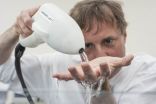Unlocking secrets of how fossils form
2015-09-16
(Press-News.org) Fossils tell amazing stories and inspire them, too -- just think of this summer's "Jurassic World" blockbuster. But because some of the processes that preserve fossils are not well understood, there's still more information that they could reveal. Now scientists report in ACS' journal Analytical Chemistry a new way to probe fossils to find out how these ancient remains formed in greater detail than before.
When most organisms die, they biodegrade and leave little behind. But if they get trapped in sediments that harbor few bacteria and loads of dissolved minerals, they can become fossilized and preserved for millions of years. Scientists use a variety of techniques on the ancient specimens to determine details about lifestyles and diets, as well as information about the geographical distribution of the creatures. One of those methods called scanning electron microscopy, or SEM, showed particular promise for revealing new information about fossils. So Amauri J. Paula and colleagues expanded on this method.
The researchers used a large-field SEM approach to analyze a shrimp fossil from the Araripe Basin, a place in northeastern Brazil known among paleontologists as a treasure trove of flying pterosaur remains. The shrimp specimen dates back to the Cretaceous period, when dinosaurs still roamed the planet. The technique provided evidence for the first time that a rare fossilization process occurred in the basin. It also showed that the fossil over millions of years developed a surprising fractal characteristic -- a still-unexplained, repeating pattern most commonly recognized in snowflakes but also found in structures as large as spiral galaxies.
INFORMATION:
The authors acknowledge funding from the Conselho Nacional de Desenvolvimento Científico e Tecnológico of Brazil and the Fundação Cearense de Apoio ao Desenvolvimento Científico e Tecnológico.
The American Chemical Society is a nonprofit organization chartered by the U.S. Congress. With more than 158,000 members, ACS is the world's largest scientific society and a global leader in providing access to chemistry-related research through its multiple databases, peer-reviewed journals and scientific conferences. Its main offices are in Washington, D.C., and Columbus, Ohio.
To automatically receive news releases from the American Chemical Society, contact newsroom@acs.org.
Follow us: Twitter
Facebook
ELSE PRESS RELEASES FROM THIS DATE:
2015-09-16
Coughing. A sore throat. Maybe a pain in your chest as you take a deep breath.
These are all common symptoms for many city-living Australians when smog levels are high. And while it is well understood that smog can cause such problems, new research has for the first time given us a glimpse as to what might be happening at the molecular level.
The University of Melbourne's Professor Richard O'Hair, from the School of Chemistry's Bio21 Institute, in collaboration with Professor Stephen Blanksby (from the Queensland University of Technology and formerly the University ...
2015-09-16
Researchers from the University of Southampton have demonstrated how a pioneering ultrasonic device can significantly improve the cleaning of medical instruments and reduce contamination and risk of infection.
StarStream, invented and patented by the University of Southampton and in commercial production by Ultrawave Ltd., makes water more efficient for cleaning by creating tiny bubbles which automatically scrub surfaces. The device supplies a gentle stream of water through a nozzle that generates ultrasound and bubbles, which dramatically improve the cleaning power of ...
2015-09-16
This news release is available in German.
Platinum is a great catalyst and can be used for many different applications. It's expensive stuff though, so tiny platinum nanoparticles sitting on cheap metal oxide materials are used to convert harmful carbon monoxide into carbon dioxide. Using scanning tunnelling microscopes, scientists at TU Vienna have now been able to image the catalytic behaviour of platinum sitting on iron-oxide, which allowed them to explain the process on an atomic scale. Surprisingly, the chemical reactions do not take place on the platinum ...
2015-09-16
Researchers at the University of Birmingham have shown how the development of coated silica nanoparticles could be used in restorative treatment of sensitive teeth and preventing the onset of tooth decay.
The study, published in the Journal of Dentistry, shows how sub-micron silica particles can be prepared to deliver important compounds into damaged teeth through tubules in the dentine.
The tiny particles can be bound to compounds ranging from calcium tooth building materials to antimicrobials that prevent infection.
Professor Damien Walmsley, from the School of ...
2015-09-16
This news release is available in German.
Topical research experiments are often too expensive or too complex to be rebuilt and incorporated in teaching. How can one, nevertheless, make modern science accessible to the public? This challenge was tackled in the research group Quantum Nanophysics led by Markus Arndt at the University of Vienna. For the first time, two research laboratories were created as complete, photorealistic computer simulations allowing university and high-school students as well as the general public to virtually access unique instruments. ...
2015-09-16
EUGENE, Ore. -- (Sept. 16, 2015) -- New research at the University of Oregon finds that an organization's logo on a food product can trigger quick perceptions by consumers about an item's healthiness and influence their decision-making.
That perception also may be seen as an endorsement that may not exist, say study co-authors Elizabeth Minton of the University of Wyoming and T. Bettina Cornwell, the Edwin E. & June Woldt Cone Professor of Marketing in the Lundquist College of Business at the UO.
The research, led by Minton as part of her doctoral dissertation at the ...
2015-09-16
TORONTO [11 September 2015] A team of astronomers has given us our best view yet of an exoplanet moving in its orbit around a distant star. A series of images captured between November 2013 to April 2015 shows the exoplanet β Pic b as it moves through 1 ½ years of its 22-year orbital period.
First discovered in 2008, β Pic b is a gas giant planet ten to twelve times the mass of Jupiter, with an orbit roughly the diameter of Saturn's. It is part of the dynamic and complex system of the star β Pictoris which lies over 60 light-years from Earth. The ...
2015-09-16
The use of antidepressants during pregnancy has no long term neurodevelopmental or behavioural effects on the child, however they may be associated with an increased risk of postpartum haemorrhage, suggests the findings from three studies published in BJOG: An International Journal of Obstetrics and Gynaecology (BJOG).
Depression and anxiety are the most common mental health problems during pregnancy, with around 12% of women in the UK experiencing depression at some point during pregnancy and the postnatal period. The use of antidepressants such as selective serotonin ...
2015-09-16
Stanford University School of Medicine researchers and their colleagues are calling for an urgent re-evaluation of global guidelines for the treatment of parasitic-worm diseases in light of a new study showing that large-scale treatment programs are highly cost-effective.
Parasitic-worm diseases afflict some 1.5 billion people in the developing world, causing gastrointestinal problems, anemia, wasting, and cognitive and growth deficits in children, and in some cases, liver, bladder and intestinal problems that can be fatal. About 150,000 people die of complications from ...
2015-09-16
CANCER RESEARCH UK scientists have found how cells adapt to overcome cancer drugs designed to interfere with their genetic controls, according to a study* published today (Wednesday) in Epigenetics and Chromatin.
Normally molecular 'tags' are attached to DNA which send signals to the cell, telling it how to package its DNA and switch genes on or off.
Drugs called HDAC inhibitors cause a build-up of certain types of tags, leading to potentially damaging changes in gene activity that can kill cancer cells.
But while HDAC inhibitors can successfully treat certain types ...
LAST 30 PRESS RELEASES:
[Press-News.org] Unlocking secrets of how fossils form



